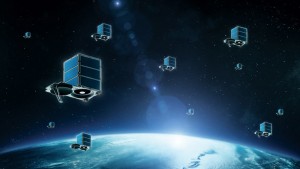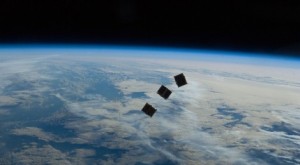Posted at 15:14h
in
Space
by Shen Ge
[caption id="attachment_237" align="alignleft" width="300"]

A Silicon Valley startup plans to launch a fleet of high-resolution and cheap imaging satellites. Image: Jeff Lysgaard[/caption]
Want to See the Full Earth in High Resolution?
Who doesn't want to see real-time high-resolution images of our planet? If you have used a service such as Google Earth, you may have been awed by its beautiful depiction of almost any region on our planet. You may even think that the images are real-time or at most just a few days old. Alas, that is not true. Weather satellites which does provide real-time data (updated every few hours) of the entire Earth operates at what's known as geosynchronous orbits (36,000 km from the Earth) and from that distance, can't offer high resolution pictures. Even a global imaging satellite such as NASA's MODIS Terra satellite provides only medium resolution (about 250 meters per pixel). The high-resolution images of Earth beautiful to us and more importantly, useful for government and industry to analyze global shipping, oil spills, crop irrigation, etc., are covered by closer satellites in low earth orbit (several hundred kilometers from the Earth) operated by companies such as GeoEye or DigitalGlobe. Unfortunately, those high-resolution satellites only see small potions of the Earth so there is are complicated algorithms at Google and other satellite image companies to update images with the newest ones and splice them together.
Who is Skybox Imaging?
Skybox Imaging is a high-resolution imaging and data company recently [June 2014] acquired by Google for $500 million. Starting from 2009 when four Stanford university students worked out of a cramped living room, they have grown into a multimillion dollar backed 125-person company in Silicon Valley with their own satellite manufacturing and operations facilities as well as data equipment and software to handle their satellite information. The company designs its own satellites and cameras and partners with others to build and launch them. Prior to their acquisition by Google, they have raised a total of $91 million in three rounds of financing from venture capital companies.
Interested in more of my posts and other writings outside of Impact Hound? Follow me on Twitter:
@shenge86




 A Silicon Valley startup plans to launch a fleet of high-resolution and cheap imaging satellites. Image: Jeff Lysgaard[/caption]
Want to See the Full Earth in High Resolution?
Who doesn't want to see real-time high-resolution images of our planet? If you have used a service such as Google Earth, you may have been awed by its beautiful depiction of almost any region on our planet. You may even think that the images are real-time or at most just a few days old. Alas, that is not true. Weather satellites which does provide real-time data (updated every few hours) of the entire Earth operates at what's known as geosynchronous orbits (36,000 km from the Earth) and from that distance, can't offer high resolution pictures. Even a global imaging satellite such as NASA's MODIS Terra satellite provides only medium resolution (about 250 meters per pixel). The high-resolution images of Earth beautiful to us and more importantly, useful for government and industry to analyze global shipping, oil spills, crop irrigation, etc., are covered by closer satellites in low earth orbit (several hundred kilometers from the Earth) operated by companies such as GeoEye or DigitalGlobe. Unfortunately, those high-resolution satellites only see small potions of the Earth so there is are complicated algorithms at Google and other satellite image companies to update images with the newest ones and splice them together.
Who is Skybox Imaging?
Skybox Imaging is a high-resolution imaging and data company recently [June 2014] acquired by Google for $500 million. Starting from 2009 when four Stanford university students worked out of a cramped living room, they have grown into a multimillion dollar backed 125-person company in Silicon Valley with their own satellite manufacturing and operations facilities as well as data equipment and software to handle their satellite information. The company designs its own satellites and cameras and partners with others to build and launch them. Prior to their acquisition by Google, they have raised a total of $91 million in three rounds of financing from venture capital companies.
Interested in more of my posts and other writings outside of Impact Hound? Follow me on Twitter:
A Silicon Valley startup plans to launch a fleet of high-resolution and cheap imaging satellites. Image: Jeff Lysgaard[/caption]
Want to See the Full Earth in High Resolution?
Who doesn't want to see real-time high-resolution images of our planet? If you have used a service such as Google Earth, you may have been awed by its beautiful depiction of almost any region on our planet. You may even think that the images are real-time or at most just a few days old. Alas, that is not true. Weather satellites which does provide real-time data (updated every few hours) of the entire Earth operates at what's known as geosynchronous orbits (36,000 km from the Earth) and from that distance, can't offer high resolution pictures. Even a global imaging satellite such as NASA's MODIS Terra satellite provides only medium resolution (about 250 meters per pixel). The high-resolution images of Earth beautiful to us and more importantly, useful for government and industry to analyze global shipping, oil spills, crop irrigation, etc., are covered by closer satellites in low earth orbit (several hundred kilometers from the Earth) operated by companies such as GeoEye or DigitalGlobe. Unfortunately, those high-resolution satellites only see small potions of the Earth so there is are complicated algorithms at Google and other satellite image companies to update images with the newest ones and splice them together.
Who is Skybox Imaging?
Skybox Imaging is a high-resolution imaging and data company recently [June 2014] acquired by Google for $500 million. Starting from 2009 when four Stanford university students worked out of a cramped living room, they have grown into a multimillion dollar backed 125-person company in Silicon Valley with their own satellite manufacturing and operations facilities as well as data equipment and software to handle their satellite information. The company designs its own satellites and cameras and partners with others to build and launch them. Prior to their acquisition by Google, they have raised a total of $91 million in three rounds of financing from venture capital companies.
Interested in more of my posts and other writings outside of Impact Hound? Follow me on Twitter: 